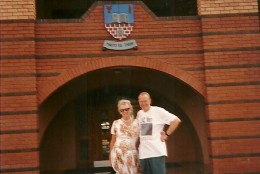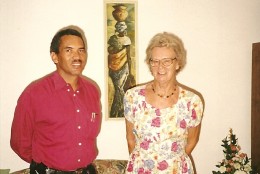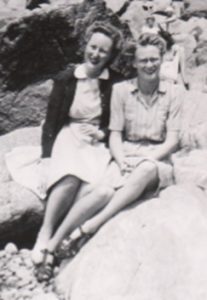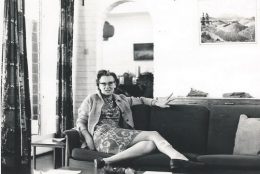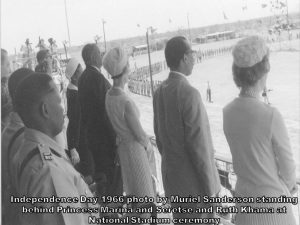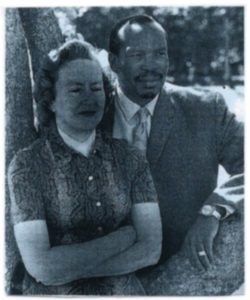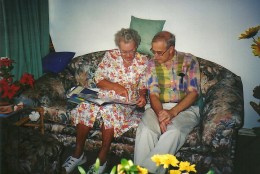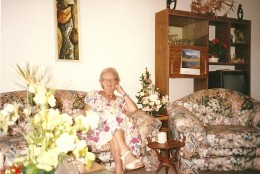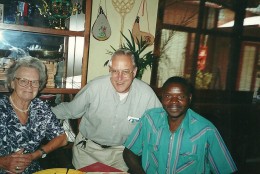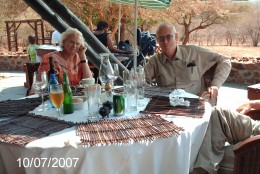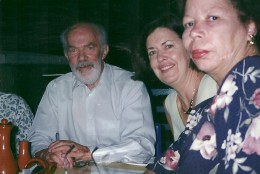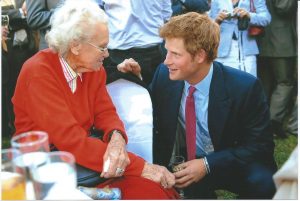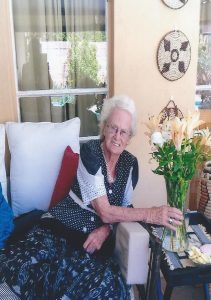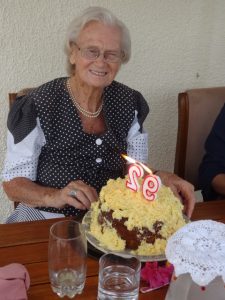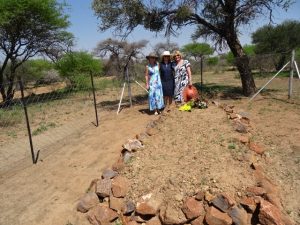Muriel Williams Sanderson, David Wilkin and 50 years of correspondence: 1965-2015
- Outside Univ. of Botswana
- Ian Khama and Muriel Williams Sanderson
- Muriel & David hanging out laundry
The above pictures were taken in 1997 or 1998 in Gaborone after Muriel had retired to Botswana.
Special note: The latest film about the Khama family was released late in 2016 and opened in NYC in mid-February 2017. Although the well-known actors and actresses certainly don’t look much like the real Seretse, Ruth and Muriel(!), they are excellent in their roles. (David Oyelowo plays Seretse.) It follows the story of their lives reasonably accurately. Here are clips, reviews and articles in late 2016 or early 2017:
- Daily Mail review of film: A United Kingdom — Daily Mail review
- YouTUBE preview: A link to “A United Kingdom:” YouTube
- Two reviews and articles in the New York Times: Movie review and also Oyelowo interview
Muriel, David and the NWP. Muriel lived in Kitwe, only 190 km. east of the Solwezi, when we met in late 1963. She rarely drove west to visit me (David) in the NWP. Rather, much more frequently, I drove east and stayed with her and her friends when I made trips to Kitwe in the Copperbelt to get supplies. For anyone just seeking info’ on the NWP, this correspondence may seem peripheral to this website. She did, however, have a huge effect on me in the NWP and many others in Zambia, Botswana and, all of Africa. Some of her letters are remarkable and a source of historical importance to all interested in southern Africa during the last 50 years. Shortly after she died in June 2015, a close mutual friend wrote the following poignant memorial essay or biography, Please read it next before reading this short commentary about her and her letters and our friendship.
A Memorial Biography (essay):
Muriel Sanderson neé Williams
(born 31 Oct. 1921, died 25 June 2015)
Muriel Sanderson neé Williams is well known as the person who introduced her younger sister Ruth to Seretse Khama at Nutford House, London, in 1947. This famous encounter also led to Muriel’s long relationship with the Khama family and Botswana, where she spent the last twenty years of her life.
Apart from her close friends, however, few will be aware of Muriel’s own remarkable life, especially the one she led after leaving the UK in 1960 to join the Mindolo Ecumenical Foundation (MEF), in Kitwe, on the Zambian Copperbelt. The MEF was founded in 1958 to promote African development at a time when many whites in Northern Rhodesia were resisting democracy and favouring the perpetuation of white rule under the Central African Federation. At MEF, African nationalists such as Kenneth Kaunda were taken seriously, supported in their efforts and placed in consultations with whites willing to sit round the table. By the time independence came in 1964, Muriel was a member of Kaunda’s United National Independence Party (UNIP). In 1965 she became a Zambian citizen and was elected (unopposed) to the Kitwe city council. The MEF ran courses of many types, and its Women’s Centre became the seed-bed of the women’s movement in the country. The Young Women’s Christian Association of Zambia was born at Mindolo, and Muriel served as national treasurer for 37 years and represented the Zambia YWCA abroad. Muriel was a friend of President Kaunda and many cabinet ministers, national and local office holders. She was also a member of the congregational St. Margaret’s church (where she too was treasurer), a member of the United Church of Zambia, and through her church and MEF work a representative at meetings of the All African Council of Churches in Zambia and other countries in Africa.
She served as MEF’s Accountant from 1960 to 1976 and, after managing a travel agency in Kitwe, returned to the MEF as Financial Controller from 1988 to 1995 (and as Acting Director from 1991-1992). Bookish, widely read and travelled, with interests in film, tennis, international politics, theater, gardening, and most of all, swimming, Muriel retired in 1995 and relocated to Botswana to live near her sister, niece, nephews and great nephews. In Gaborone, she volunteered her accounting and other talents to the Methodist church and other local organisations, and was a life member of the Botswana Society. She remained a Zambian citizen.
Throughout her life, Muriel was a remarkable observer. Her correspondence, particularly her annual letters to keep her legion of friends informed of her activities, provides much information about the world of which she was a part and many insights into the persons who were shaping it. She wrote fluidly, descriptively, with neat turns of phrase and humourous off-side comments. While living in Zambia, Mrs. Sanderson visited Botswana often, and was unique among its witnesses during the early years of independence, because of her closeness to Ruth, Seretse and their family and her detachment from Botswana as a Zambian. She was present at the swearing in of the late Seretse Khama as Prime Minister, the year prior to Botswana’s formal independence, when he became the first President. Her description of Gaborone, itself scarcely one year old, was typical of Mrs. Sanderson’s impeccable eye.
“Gaberones has to be seen to be believed. If you think of the old American film of opening up the West, you are getting warm. It is still being built, and when I was there in March, there were no street names, no numbers, precious few phones, electricity breakdowns every lunch-time and some evenings, and dust, dust everywhere.”
Known for her sharp tongue, impatience with flattery and pretense, and honesty, Muriel Sanderson died peacefully, in her sleep, age 94.
50 years. As told on the Solwezi web page, we (David and Muriel) met when I visited Mindolo Ecumenical Centre on the Copperbelt shortly after arriving in Zambia to teach at Solwezi Secondary School. We immediately became good friends and started a correspondence that quite amazingly lasted from the mid-1970s until her death in July 2015: over 35 years. In addition, several years before her death, she located many of her older form letters that she sent out several times a year to her friends and family. They go back to 1965, so this correspondence actually lasts about half a century. Equally amazing, I somehow kept the letters that we exchanged.
A beautiful writer. Our lengthy correspondence is the focus of this webpage. About 3/4 of these letters and other items are from her. Although a practicing accountant all her professional life, she was a remarkable “woman of letters.” Besides her letters to me, her descriptive form letters to friends provide wonderful insights into the rapidly evolving world around her, especially during the years when various countries in Africa gained independence. My letters (personal and form letters) are more plain and really fill in the gaps between her more vibrant ones!
Frank and honest. She always kept a wide perspective and was very sensitive to changes throughout the whole world, but especially southern Africa. She spoke very frankly (at times almost brutally so!) about what she thought and believed. This could be discomforting to even her closest friends and even family, to whom she was totally devoted. The bio’ above aptly notes that: “sharp tongue, impatience with flattery and pretense, and honesty”.
One major regret. I planned to interview Muriel on tape at some length on one of my many visits to see her after she retired to Botswana, but my own poor health between 2008 and 2011 side tracked me from doing so. As her story and story-telling abilities were so remarkable, I deeply regret not having had this intended interview(s).
A few vignettes to supplement the memorial biography above.
- Before Africa. Born in 1921, her stories of World War II were vividly recalled on many occasions, especially the bombing of London by Hitler’s Germany when she was in her 20s. Herewith a picture of the young Muriel and her mother and father:
- Muriel Williams Sanderson with her father and mother
- Lived very simply and humbly. When I met Muriel, she had a small bungalow overlooking Mindolo’s small lake that faced its charming library. Her lifestyle was very basic and plain, especially for a white, female “muzungu” (white person) in pre-Independence Zambia. Later when she had beautiful homes after marrying Murray Sanderson and when heading a travel agency in Kitwe, she simply regarded her home as a place to relax and entertain, nothing more! No pretensions. Thus, when she retired to Botswana, she lived in a simple flat near the centre of Gaborone. When Ruth, her sister, drove in from the Khama’s lovely ancestral home outside Gaborone, she was provided with a simple, single bed in the tiny spare bedroom. After Ruth died, Muriel told me that the Khama family wanted her to move into the elegant Khama home outside Gaborone. She, however, preferred staying in her more humble abode. When it became necessary to move to another place, she again took a basic two bedroom flat. Simplicity was part of Muriel’s style.
- Ruth Khama and Muriel Williams Sanderson, probably in 1940s
- Muriel William Sanderson and Zambia, Africa and the world. As the correspondence reveals, Muriel seemed to know everyone in Independence movements across Africa. She used her holidays to travel widely, especially to conferences that focused on the YWCA, the World Council of Churches, and also visits to her sister (Ruth) and brother-in-law (Seretse) in Botswana. She spoke French as well as English.
- Family: Muriel, Ruth, Seretse and their children. Although she married Murray Sanderson in Kitwe, the marriage did not last long. (Seretse Khama gave her away at an outdoor marriage ceremony that I attended at the Mindolo Ecumenical Centre.) As the Williams family in England aged and slowly died off, her family became that of Ruth and Seretse. She adored her niece and three nephews (plus great nephews) and speaks very lovingly of them throughout her correspondence. Thus, she decided to retire to Gaborone where they all lived. Though very different in temperament, she and her sister became ever closer until Ruth died from cancer, some years after Seretse’s death. Although Muriel remained very independent (and independent minded!), she increasingly depended on the family in Gaborone for general support, which they kindly provided.
- Seretse and Ruth Khama with Ian, Jackie plus Muriel and others
- Muriel: main source of information about Seretse and Ruth. At least two movies and two books about her brother-in-law and sister have appeared during the past decades. Muriel and Ruth (until her death) were the main sources of both books and movies after Seretse died. By far the best known film, “A United Kingdom,” was playing in 2017 when I wrote much of this webpage. The lead actor, David Oyelowo, acknowledges the book by Susan Williams (no relation to Muriel and Ruth) as the foundation for this movie. Herewith book references:
- Michael Dutfield, A Marriage of Inconvenience (Gaborone: Pula Press, 2001; initially, U.K.: Unwin Hyman Ltd, 1990)
- Susan Williams, Colour Bar: The Triumph of Seretse Khama and his Nation (London: Penguin Books, 2006)
Muriel & David’s Correspondence: 1965-2015
Read this paragraph before starting! This correspondence is chronological, from oldest in 1965 until Muriel’s death. All letters have been converted into pdf files. To read these files simply click the links. After each pdf file, a short paragraph starting with the phrase “Key Topics Covered” narrates a few key events during in that time period. A friend has retyped all manuscript letters and notes as our handwriting is hard to read. With a few exceptions, the retyped portions precede the original m/s text. Anyone, however, who is dedicated enough (and a masochist!) is welcome to read the original m/s letters and notes and not the retyped text. Unfortunately a few pdf pages are upside down!
To help the handful of really serious readers of Muriel’s letters, I have added my personal “Chronological Catalogue of Muriel and David Correspondence since 1965” both as a pdf file (can be read as part of the website) or Word file file (which will be downloaded). Both have 15 pages and are identical. This catalogue gives a summary of every item of our correspondence: Correspondence catalogue of Muriel & David: pdf version OR Correspondence catalogue of Muriel & David, 1965 to 2015: Word version
31st August 2019: special note. The original copies of my correspondence with Muriel have been deposited into the Botswana National Archives and will soon be available for scholarly use. A second duplicated set is already available in Syracuse University’s Archives. These two archival sets of the correspondence provide future protection should this website go down. Click the following link to read SU’s description: https://library.syr.edu/digital/guides/w/wilkin_sanderson.htm Thus, two sets of the correspondence are, or soon will be, available besides what is on this webpage.
===================================
- Muriel’s form letters to friends & family: 1965-1972 This file (pdf or Word) contains 11 letters totaling 35 pages. Key topics covered: Seretse became first President of Botswana; she became a Zambian citizen and a UNIP city councilor for Kitwe; Haile Selassie visited Mindolo; an excellent description of the Non-Aligned Conference at Mulungushi in Sept. 1970; her marriage (and divorce) to Murray Sanderson.
In this period from 1965 to 1971 Muriel lived solely in Kitwe. Zambia’s independence in Oct. 1964 had just passed and Botswana’s had not yet come. Her 11 remaining form letters to her friends in this period — along with those from 1972-78 — are possibly her most important letters historically. (I did not keep any of our personal letters until 1979.) During this period, I moved from Solwezi to Zambezi (Balovale) — 550 km to the west — at the beginning of 1965 — to head the new secondary school. Then, in 1968, I left Zambia to start work on my Ph.D. at Syracuse University. This was followed in 1971 by a year in Kenya before my return to Lusaka (UNZA). (These events are described in “David’s Story with Photos.”)
My two letters about Muriel and Murray’s wedding on 30th April 1966. Muriel’s three page letter before the wedding was written on 8th March 1966 (pages 13-16 in the pdf or Word versions of her letters). Her next available letter is on 12 November 1967. At least one of her form letters in late 1966 is lost. This would have described details of the wedding and its quick deterioration. (In the many years following, I never, ever, asked, her anything about their relationship, nor did she volunteer information.) Only I could attend the wedding in Kitwe, as Zindi had to work in Zambezi (550 km. to the west).
I had misfiled these letters and only relocated them in early Sept. 2017. Here is what I said in two letters dated 10th May 1966 and 29th May 1966. These extracts are in red, but anyone really interested should first read Muriel’s long 8th March description about the wedding plans.
10th May 1966, written after I returned from my holiday with Zindi, “I wrote you [to my parents] about and then made a separate journey to the Copperbelt . . . largely on business. . . . When on this business journey, I went to one of the biggest weddings of the year. Seretse Khama (Prime Minister) of Bechuanaland was the man to give away the bride, Miss Muriel Williams to Murray Sanderson. I know Muriel quite well from my Copperbelt journeys. Seretse is her brother-in-law. (He married an English woman 20 years ago, namely Ruth Williams, her sister.) The wedding was informal but very dignified and THE social event as Seretse afterwards visited the state house and Dr. Kaunda. Quite exciting. I’ll tell you more next time.”
28th May 1966. “I’ll start with the lovely wedding I described [last time]. I am enclosing a page cliping from the Times of Zambia (the main daily newspaper. [clipping now lost] Probably the clipping describes most everything. The service was in both English and ChiBemba and very multiracial — which was appropriate for the occasion. Although the couple are both European (white) they are very actively involved with the African government and both African and European communities. The big attraction as I told you before was that Seretse Khama of Bechuanaland gave the bride away. He is Muriel’s brother-in-law and will be Bechuanaland’s first president when it becomes independent next year as Botswana. It was a lovely celebration with a marvelous outside dinner reception for 200 to 300 people. We were sorry that Zindi couldn’t go.“
As noted above and on the Solwezi page, I met Muriel in 1963 and visited her and her Mindolo friends often when I drove to Kitwe from Solwezi. Here are several duplicate pictures of her and her friends that I used on the Solwezi page (left to right). They were Muriel with President Kenneth Kaunda; Muriel relaxing in her home in Kitwe; and her friends Geoffrey Iredale and Jones Banda when they visited me in Solwezi and we drove to Mutanda Mission and their small falls. (I no longer recall the exact dates.)
- Muriel Williams Sanderson receiving award from Pres. Kenneth Kaunda
- Muriel Williams Sanderson relaxing at Mindolo
- Mike Warburton, Jones Banda & Jeff Iredale
The following picture from this period was sent to me by Sarah Ward in Nov. 2016. She said it was taken by Muriel. The wording says: “Independence Day 1966 photo by Muriel Sanderson standing behind Princess Marina and Seretse and Ruth Khama at National Stadium ceremony.”
- Botswana’s Independence Day 1966
- Muriel’s form letters to friends & family: 1972-1978 (This pdf file has 36 pages.) Key topics: Along with the prior years (1965-71), this period from 1972-78 was possibly the peak of Muriel’s life. She still lived in Kitwe and focused on Mindolo but was traveling frequently for the YWCA and the World Council of Churches. Regarding herself and family, she celebrated her 50th birthday, describes Seretse and Ruth’s 25th anniversary, Ian’s graduation from Sandhurst and Jackie’s wedding. (In this period I was in Lusaka before going back to Solwezi to open a new office for UNZA.)
While the top right picture of Jackie and the twins was in this time period, the top left picture of Seretse and Ruth with baby Ian and Jackie was obviously much earlier. The bottom two pictures of Ruth and Seretse and Ian may have been in this period of 1972-1978 — I am no longer sure.
- Seretse & Ruth w/Ian & Jackie
- Twins and Jackie
- Ruth and Seretse
- Ian Khama
- Muriel & David’s Correspondence: 1978. (This pdf file has 7 pages.) This recently located file was the first of our personal correspondence that I can find. Her letter was dated 13th Sept. and my reply was 25th Sept. She was in Kitwe and I was in Solwezi. No key news! She had a visit by her sister; also had car problems as I did. We hoped to meet shortly.
- Muriel & David’s Correspondence: 1979-1980. (This pdf file has 37 pages.) Key topics: In many letters, Muriel described her travels and conferences as well as Mindolo. Also, shortages in Zambia before Zimbabwe’s independence; and Zambia’s security issues and economic problems. In one of the best letters, on 21th Sept. 1980 Muriel describes Seretse’s final days and death and its effect on everyone.
- Muriel & David’s Correspondence: 1981-1982. (This pdf file has 27 pages.) Key topics: Ruth’s award and her busy life in Botswana. Social and political issues in Zambia. Muriel’s plans for a trip to USA and a form letter reflecting on the trip; a visit to Amsterdam; and update on Mindolo.
Special note: On 23 Nov. 2016, I received a new photo of Muriel with the following explanation from Patsy (Rossom / Rixom) Davies, Muriel’s former workmate at TG Travel in Kitwe along with the following explanation: “Here is the newspaper cutting about the TG trip to Holland. It was in March 1982 & Muriel talks about it in her 30 Oct 1982 letter to you. One of my most vivid memories was when she was asked to leave the Rijks Museum because she was eating an apple as we went through the front door. We waited whilst she finished it outside and then she made a big show of opening her mouth as we passed the guard so he could see she had swallowed it all!!”
- Muriel: back row center
- Muriel & David’s Correspondence: 1983-1984. (This pdf file has 37 pages.) Key topics: Ruth’s home destroyed by fire; general Kitwe news and Mindolo’s 25th Jubilee; Managing Director of Turnbull Gibson; YMCA trip to Far East; Zambian severe shortages and the country’s 20th Anniversary.
- Muriel & David’s Correspondence: 1985-1986. (This pdf file has 26 pages.) Key topics: Severe shortages continue in Zambia as economy collapses; and her visits with family in Botswana. Events following David’s completing his Ph.D.; starting a new career. Zindi’s serious health issues.
- Muriel & David’s Correspondence: 1987-1988. (This pdf file has 21 pages.) Key topics: Australian holiday w/Ruth; hip surgery in U.K.; Mindolo news
- Muriel & David’s Correspondence: 1989-1990. (This pdf file has 33 pages.) Key topics: Visits in Kitwe by the Pope, Anglican Archbishop and Ian Khama; visits to Botswana to see family; Zambia’s economic and AIDS crises; A Marriage of Inconvenience is filmed in Botswana. Zindi’s death at The Riverside Church in NYC.
- Muriel & David’s Correspondence: 1991-1992. (This pdf file has 41 pages.) Key topics: Muriel’s 10 week British holiday. David’s plans for and visit to southern Africa (including Kitwe and Muriel) with three Riverside Church friends: Heidi, Elise & Ruth. New government in Zambia and its serious problems. Visits to Botswana and esp. the unveiling of Seretse’s statue.
- Muriel & David’s Correspondence: 1993-1994. (This pdf file has 37 pages.) Key topics: Muriel’s hip surgery and plans for retirement from Mindolo. Visits to Botswana and Khama family affairs and their Okavango and Chobe safaris. David’s visit to Iceland and then Heidi in Germany and also his continuing work at Merrill Lynch.
- Muriel & David’s Correspondence: 1995-1996. (This pdf file has 41 pages.) Key topics: Retirement from Mindolo and move to Gaborone, Botswana. Eye surgery and three months in U.K. Volunteer work at her new church. David’s visit to southern Africa.
- Muriel & David’s Correspondence: 1997-1998. (This pdf file has 43 pages.) Key topics: We both describe our wide travels in different parts of southern Africa. We did not, however, see each other except for my first visit to Gaborone when Petulo Njovu and I stayed with Muriel; her 75th birthday celebration at Mokolodi; other narratives with Khama family news.
- Muriel and Ruth
Notes: Muriel had moved from Zambia to Botswana settleing into a small, but comfortable flat near the centre of town. The picture above of Muriel and Ruth was probably taken after Muriel resettled in Botswana. The pictures below are duplicates from the beginning of this webpage. They show Muriel and I outside the University of Botswana, then her and Ian; and on the right, simply hanging out laundry!
- Outside Univ. of Botswana
- Ian Khama and Muriel Williams Sanderson
- Muriel & David hanging out laundry
- Muriel & David’s Correspondence: 1999-2000. (This pdf file has 28 pages.) Key topics: Muriel’s heart surgery (Jo’burg) in Feb. 2000 (Ruth visited her and gave support); later, knee surgery (Dec. 2000). David’s 60th birthday and his work at Merrill Lynch.
Note: Over the next decade, I visited Muriel many times when traveling to southern Africa. The pictures below were all taken in Muriel’s home: showing me her photograph albums (left); Petulo (right) who traveled with me a number of times.
- Muriel w/ her photo album
- Muriel
- Muriel, David & Petulo
- Muriel & David’s Correspondence: 2001-2002. (This pdf file has 33 pages.) Key topics: Both of our reflections about 9/11 in NYC with David describing how it totally changed his life and work. Her travels within Botswana with family. Also her visit to U.K.; Ruth’s death on 23rd May 2002 and her 80th birthday.
Note: In this period I visited her a number of times and we spent many days together, generally dining out for lunch. A favorite place to eat was Mokolodi Game Park restaurant (pictures on the left). On the right is Muriel’s niece, Jackie and two friends when we were dining at a restaurant in a new shopping mall.
- Dining out at Mokolodi
- Possibly Mokolodi
- Friends and niece (right)
- Muriel & David’s Correspondence: 2003-2004. (This pdf file has 37 pages.) Key topics: Muriel receiving the M.B.E. in Feb. 2003; hit by a car near her flat in early 2004. George W. Bush’s pathetic six-hour visit to Botswana (contrasted to Bill Clinton’s more pleasant visit a few years before); Muriel’s holiday to Mauritius. David’s southern African trips and his new career at the NY Psychiatric Institute.
Note: Muriel knew I liked Botswana’s colorful postage stamps. On this envelope (2000) are pictures of her late brother-in-law, Seretse Khama (far right) and on the left are his father and other early rulers of the kingdom prior to the emergence of Botswana.
- Botswana stamps
- Muriel & David’s Correspondence: 2005-2006. (This pdf file has 34 pages.) Key topics: Muriel’s travels within Botswana and family news; new book out: Color Bar. Planning a complex journey to an island off of Madagascar.
- Muriel & David’s Correspondence: late 2006-2009. (This pdf file has 18 pages.) Key topics: Vivid description of her trip to an island off Mozambique (late 2006); journeys were “utter hell.” Ian became President on 1st April 2008. Moved to new flat in Gaborone where she later died.
Notes: By 2006, our written correspondence had decreased as it was increasingly supplemented by phone calls every month to six-weeks. Also Fred and Sue Morton returned to Botswana (to live in a suburb of Gaborone). As Muriel and they got each other well, this became another source of personal news. The picture below was taken in mid-2010 when Prince Harry was visiting Botswana. Muriel was pleased that he sat down beside her for a good chat at an official party for him.
- Muriel & Prince Harry
- Muriel & David’s Correspondence: 2010-2015. (This pdf file has 45 pages.) Key topics: Cousins from England visited; trip to Mozambique; Ian’s hard work as President; a health collapse and problems thereafter of reading, etc. Family matters and get-togethers; could no longer swim, walk or read but had a final trip to South Africa with help from family.
- Final pictures of Muriel. In October 2012, Muriel sent me one of her on the the sunny veranda of her flat. (This was about two years after my final trip to southern Africa and Botswana.) Later in Nov. 2016, Sarah Ward sent me two, one from Muriel’s 92nd birthday and one taken at a club gathering with her friends.
- On her verandah
- 92nd birthday
- With friends in Gaborone
Memorials to and memories of Muriel
- A 2015 birthday memorial for Muriel by friends and family. Carole Ann Leith forwarded an email from Sarah Ward dated 30 October 2015. (Muriel’s birthday was 31 October.) Sarah said that she, “Jill and Dinky … went to Auntie Muriel’s grave at Kenmoir, Ruretse. Susan wrote and read a most beautiful and fitting ‘address’ for her. . . . Jill read a lovely poem and Sarah said a short poem.” Read Susan’s “address” October 2015 Memorial.
- Memories by long-time friends in late 2015 after Carole Ann Leith notified Muriel’s long time friends of her passing. You may read these memorial letters from her numerous friends in this pdf file: Memories of Muriel.
- Carole Ann also described her relationship to Muriel as follows: On 1st July 2016, she said: “Muriel and I were part of a large expat community, that noticeably shrank in the last ten years, after Botswana was declared a “middle-income country“ and many expat donors left for more desperate areas of need. She often came to events with Lady Ruth, but following Ruth’s death, Muriel continued to socialize. In 2003 I moved into a neighbourhood close to where she was living. I often took her to events during the day and evenings after she stopped night driving. Weekly lunches and similar interests, such as the Botswana Society, and the Kalahari Conservation Society, were a feature we both enjoyed, bringing us closer together. In the last few years I helped with her correspondence, writing letters as she dictated, and making the address labels for the envelopes. It was that address list which I used to inform her friends from different parts of the world who may not have been aware of her death.”
- Memorial comments (emailed) in 2016: On 27 April Edward Hawley recalled the days in the UK in the late 1940s. He said: “I first met Muriel at a gathering at Llanmadoc near Swansea, Wales in September of 1947. The group was the Livingstone Fellowship, a youth group organized by the London Missionary Society associated with the Congregational Churches. I was then a divinity student in a Congregational institution in Chicago and was recruited to go to Britain to fill the gap by the closure of all similar programs in Great Britain during the war. Muriel was a member of a LF group in a Congregational Church near her home in southeast London. The LMS had brought people from various parts of the world who had come to the UK to study, including, of course, Botswana. Between Christmas and New Years Day a reunion of those at Llanmadoc was held in a Congregational Church in Ipswich. There Muriel pulled me aside to tell me the dilemma and her sister were facing at home. She had been invited by two men from Botswana (Seretse was not one of them) to a party at heir hostel. She had a good time and they encouraged her to bring her sister the next time. The rest is history. Muriel was sure that when her father got wind of Ruth and Seretse’s rapidly developing relationship they would both be kicked out of the house, as one of the men had already gone back to Botswana, and when a letter from him came to Muriel their father was already upset. I was back in Chicago in the fall of 1948 when I read in a small item in the Chicago Sun-Times about the marriage. We have kept in touch ever since.”
Patsy Davies, who worked with Muriel at TG Travel, fondly recalled her days in the Copperbelt (1960s) and her relationship with MEF (Mindolo) and Muriel as she visited MEF on the weekends. She also added that her dad owned at garage in Kalulushi and serviced MEF’s vehicles.
Many years later, long after Patsy’s memories in Zambia, Sarah Ward described her many memories in Gaborone with both Muriel and Ruth Khama. She fondly recalled Muriel at their “Thursday Loud Ladies Lunch Group.” The group consisted of 10 or 11 women from “different nationalities, all different age groups, all different interests so the conversation [was] very varied and Auntie Muriel LOVED this.”
Grave site: Oct. 31, 2016. In an email, Sarah Ward said to Carole Ann that she and two other friends (Susan and Sieglinde) visited Muriel’s grave Muriel’s birthday) at Ruretse where a headstone will be placed soon. They sent Carole Ann the photo below. Sarah noted that Muriel “would have been ninety-four years old. It is a lovely peaceful spot.” (Sarah latter emailed me with ideas of what might be placed on the headstone.
- Three friends at Muriel’s grave
On 10th April 2017, Carole Ann Leith added an interesting note about Muriel (and Ruth). She said that 50 years ago on the 10th, “The London Free Press (Section C, page 3) had an article regarding Katherine Hepburn and Sidney Poitier and the making of, “Guess who’s Coming to Dinner“. She then continued that “at a meeting of the Botswana Society a few years ago the movie was shown. Parallels were drawn to Ruth and Seretse. We saw the link, called her up and drove her, as she was becoming less willing to drive at night. I don’t remember the details of the evening as M. held forth on both the movie and and the evening.” She then said “Sidney P came to England, and wanted to meet them both: Ruth invited him for dinner. Ruth called Muriel and invited her to be the 4th for dinner. A very fine evening according to Muriel, but she could recall few details.”
==================================


